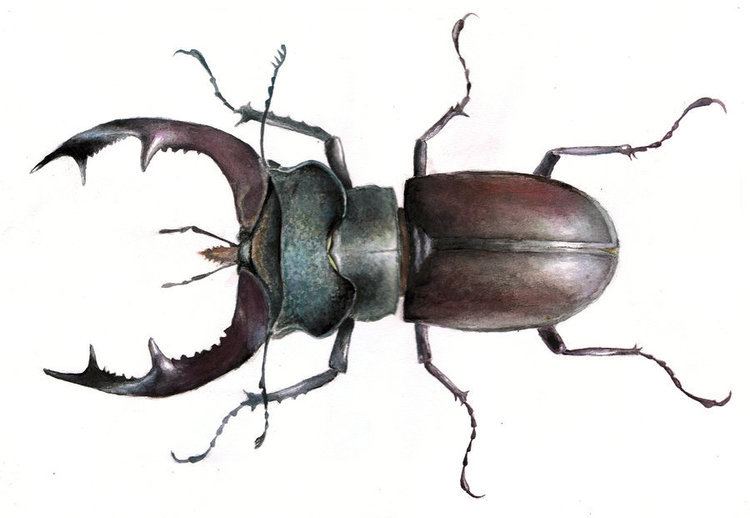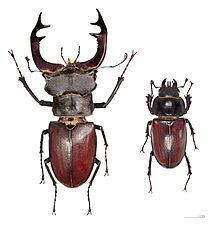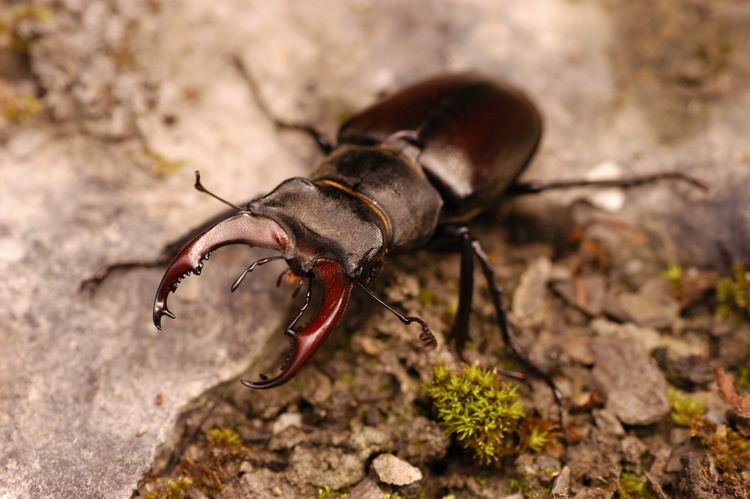Order Coleoptera Subfamily Lucaninae Rank Species | Family Lucanidae Genus Lucanus Higher classification Lucanus | |
 | ||
Similar Beetle, Lucanus, Insect, European rhinoceros beetle, Cerambyx cerdo | ||
Lucanus cervus cervus stag beetle hirschk fer
Lucanus cervus is the best-known species of stag beetle (family Lucanidae) in Western Europe, and is the eponymous example of the genus. L. cervus is listed as Near Threatened by the IUCN Red List.
Contents
- Lucanus cervus cervus stag beetle hirschk fer
- Taxonomy
- Description
- Distribution and habitat
- Lifecycle
- Behaviour and ecology
- Predators
- Parasites
- Protection
- As a toy
- References

Lucanus cervus cervus stag beetle hirschk fer
Taxonomy

L. cervus includes two subspecies: L. c. cervus (males: 35–92 mm, females: 35–45 mm; ) and L. c. judaicus (males: 50–100 mm, females: 40–50 mm)
Description

Sexually dimorphic, the males have enlarged mandibles and are larger than the females. Although the male's mandibles seem threatening, they are too weak to be harmful. Nevertheless, females can inflict a painful bite. The resemblance of the male's mandibles to the horns of a stag, and their use in combat between males, much like with deer, gives the species its scientific and common names.
Adult size varies between different areas of its distribution, for example beetles from Spain, Germany, and the Netherlands are larger than those from Belgium or the UK.
Distribution and habitat
L. cervus is widespread across Europe., though it is absent from Ireland. In Germany it is widespread, mainly in the south.In Hungary this species is widespread in the hilly and mountainous areas. In Romania it is widespread, especially in the hilly areas with sun exposed slopes. It also occurs in the European part of Turkey. In Italy it is mainly distributed in northern and central regions. In Spain and Portugal it is present only in the northern half of each country. In Britain it is largely confined to the south-east of England, where it is widespread. This species is now extinct in Denmark and Latvia. It is also found in Caucasus, Asia Minor, Syria and west Kazakhstan. Its range is currently only increasing in Croatia and Slovakia.
L. cervus has been associated with a range of trees including those in the families Oak (Quercus), Lime (Tilia), Beech (Fagus), Willow (Salix) and specific species from other families including Black poplar (Populus nigra), Ash (Fraxinus excelsior), Horse-chestnut (Aesculus hippocastanum), wild cherry (Prunus avium), and Common walnut (Juglans regia).
Lifecycle
Adults appear during late May to the beginning of August, being most active in the evenings. Females lay their eggs in a piece of decaying wood deep in the soil. Stag beetle larvae, which are blind and shaped like a letter "C", feed on rotting wood in a variety of places, tree stumps, old trees and shrubs, rotting fence posts, compost heaps, and leaf mould. The larvae have a cream-coloured, soft, transparent body with six orange legs, and an orange head which is very distinct from the very sharp brown pincers. They have combs in their legs which they use for communication (stridulation) with other larvae. The larvae go through several instar stages, taking 4 to 6 years to become pupae.
The work of entomologist Charlie Morgan during the late 1970s discovered that the pupae of the stag beetle live in the soil for about 3 months, then emerge in summer to awkwardly fly off to mate. Adults only live for a few weeks, feeding on nectar and tree sap. Their slow, lumbering flight, usually at dusk, makes a distinctive low-pitched buzzing sound. The males fly more readily than the females.
Behaviour and ecology
The natural reaction of the beetle to an approaching large object is to remain motionless, making them a good photographic subject.
Predators
Natural predators of L. cervus in Britain include cats, foxes, carrion crows, magpies and kestrels; these tend to strike at the most vulnerable stage in the beetle’s life cycle, when adults are seeking to mate and lay eggs. In the case of magpies, they have been observed in the field as waiting for emergence on a single site; subsequently consuming the beetle's abdomen.
In Italy, the main predator is the Hooded crow (Corvex cornix). Stuttgart 2011-05
Parasites
Mites in the order Monogynaspida (Suborder Uropodina) are phoretic (attached for the purpose of transportation) and have been observed attached to L. cervus as deutonymphs on the membrane of the joint between head and pronotum.
Protection
L. cervus is listed as Near Threatened by the IUCN Red List. Although this species is widely distributed in Europe, it is in significant decline in the north and central part of its range and future trends of European forests will pose serious threats to this species, thus making the species close to qualifying for Vulnerable.
L. cervus is registered in the second appendix of the Habitats Directive of the European Union from 1992, which requires that member states set aside special areas of conservation. The species is also registered in the third appendix of the Convention on the Conservation of European Wildlife and Natural Habitats (Berne convention) of 1982 and Schedule 5 of the UK's Wildlife and Countryside Act 1981.
As a toy
The modern Italian word for a toy kite cervo volante (and hence both the French cerf-volant and Spanish ciervo volante) may derive from the ancient amusement of flying the beetles on a length of thread.
